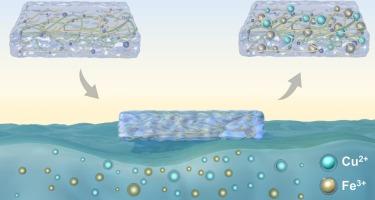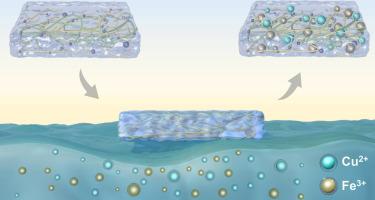A self-floating hydrogel for heavy metal recovery from water
IF 6.9
2区 材料科学
Q2 CHEMISTRY, PHYSICAL
引用次数: 0
Abstract
Heavy metal pollution is a serious environmental problem endangering the ecosystem and human health. The removal of heavy metals becomes crucial for water treatment. However, from the point of view of thermodynamics, it is a big challenge to transform the heavy metals from the homogeneous state in bulk liquid to the heterogeneous state in a collection area. Here we show a facile strategy of collecting heavy metals from bulk liquid to water surface by engineering a self-floating hydrogel. We construct the hydrophobic surfaces on the polyacrylamide/polyvinylpyrrolidone double-network hydrogel by simply coating with silica nanoparticles (SiNPs). Both of our experiments and computation analysis indicate that the SiNPs-coated hydrogel can self-float stably on the water surface, due to the balance between the interfacial tension, buoyancy force, and gravitational force. We further show that the self-floating hydrogel can effectively adsorb various heavy metals, i.e., Cu2+, Fe3+, and Ni2+, from water and enrich them inside the hydrogel, which decrease the concentration of heavy metals in water. Our findings present new insights into the hydrophobicity-induced self-floatation of soft matters on bulk liquid and provide a novel strategy for heavy metal efficient recovery, promising great applications in chemical and biosensors, drug delivery and water purification.


一种用于水中重金属回收的自浮式水凝胶
重金属污染是危害生态系统和人类健康的严重环境问题。重金属的去除对水处理至关重要。然而,从热力学的角度来看,将重金属从散装液体中的均相状态转变为收集区域中的非均相状态是一个很大的挑战。在这里,我们展示了一种简单的策略,通过设计一种自漂浮的水凝胶,将重金属从散装液体收集到水面。我们在聚丙烯酰胺/聚乙烯吡咯烷酮双网水凝胶上简单地包覆二氧化硅纳米粒子(SiNPs),构建疏水表面。我们的实验和计算分析都表明,由于界面张力、浮力和重力之间的平衡,sinps包覆的水凝胶可以在水面上稳定地自浮。我们进一步发现,自浮水凝胶可以有效吸附水中的各种重金属,即Cu2+、Fe3+和Ni2+,并在水凝胶内富集,从而降低水中重金属的浓度。我们的发现为软性物质在散装液体上疏水诱导的自浮提供了新的见解,并为重金属的有效回收提供了一种新的策略,在化学和生物传感器、药物输送和水净化方面有很大的应用前景。
本文章由计算机程序翻译,如有差异,请以英文原文为准。
求助全文
约1分钟内获得全文
求助全文
来源期刊

Applied Surface Science
工程技术-材料科学:膜
CiteScore
12.50
自引率
7.50%
发文量
3393
审稿时长
67 days
期刊介绍:
Applied Surface Science covers topics contributing to a better understanding of surfaces, interfaces, nanostructures and their applications. The journal is concerned with scientific research on the atomic and molecular level of material properties determined with specific surface analytical techniques and/or computational methods, as well as the processing of such structures.
 求助内容:
求助内容: 应助结果提醒方式:
应助结果提醒方式:


